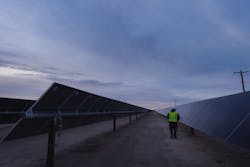SRP to Develop Utility-Scale Advanced Solar Generation at Copper Crossing
The SRP board approved phase two of development at the Copper Crossing Energy and Research Center in Florence, Arizona, which includes a utility-scale advanced solar generation facility capable of generating up to 55 MW of solar energy, or enough to power nearly 12,000 homes.
This will be the first utility-scale solar asset in SRP’s portfolio that SRP self-develops, owns and operates. Historically, SRP has contracted generation from renewable resources through power purchase agreements with developers, as these entities have access to tax credits.
The recent passage of the Inflation Reduction Act allows not-for-profit public power utilities like SRP to directly receive federal incentive payments for renewable projects. This will give SRP greater ability to develop, operate and advance more renewable resources and potentially reduce costs for customers as SRP transitions its generation fleet.
The site will have advanced solar generation, which will give SRP the opportunity to evaluate emerging commercial technology, and the experience necessary to transition to a low-carbon resource portfolio. The development will be on SRP-owned land next to the existing Abel Substation on West Judd Road and Attaway Road, adjacent to the existing 20-MW solar plant on the north side of site which currently provides energy to SRP customers.
The first phase of near-term build-out of the Copper Crossing Energy and Research Center will add two flexible natural gas turbines with a total output of less than 100 MW, which the SRP Board approved in September. A third proposed phase for small-scale, long-duration energy storage technologies, is expected to go to the SRP Board for approval in 2023.
SRP has not yet completed the design of the new solar portion of the Copper Crossing site. Detailed engineering, material procurement and construction activities for the solar facility are expected to take about 24 months.
About the Author
T&D World Staff
Content Team
Nikki Chandler
Group Editorial Director, Energy
[email protected]
Jeff Postelwait
Managing Editor
[email protected]
Christina Marsh
Senior Editor
[email protected]
Ryan Baker
Associate Editor
[email protected]
Amy Fischbach
Electric Utility Operations
[email protected]
Rich Maxwell
Community Editor
[email protected]
Gene Wolf
Technical Editor
[email protected]
